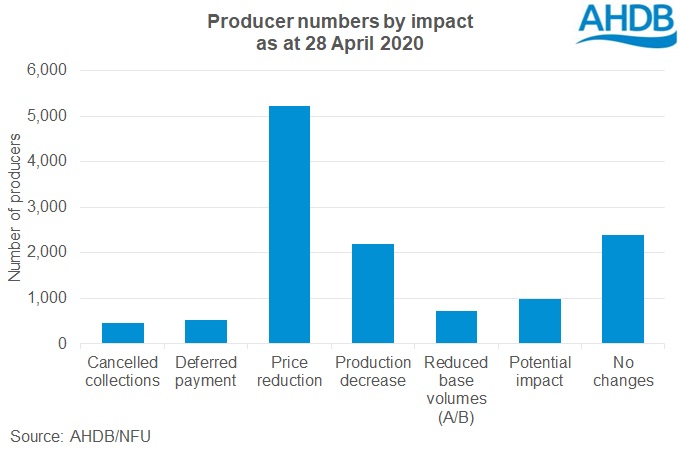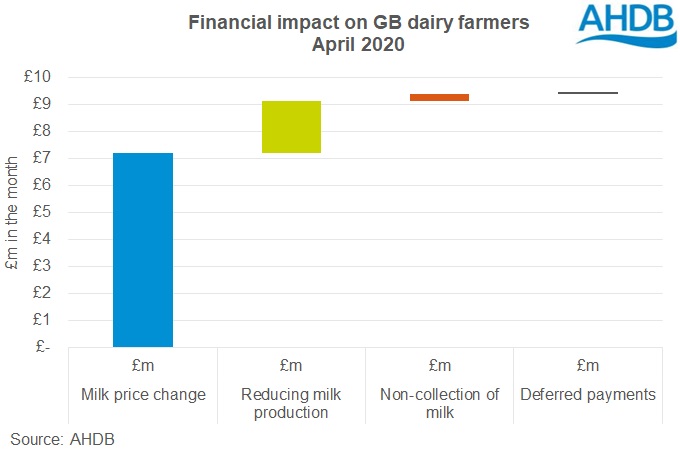The financial impact of Coronavirus on dairy farmers
Wednesday, 29 April 2020
By Chris Gooderham and Patty Clayton
The loss of foodservice markets as a result of Coronavirus has impacted on a large number of dairy farmers across GB. But just how many farmers have been affected, and what are the financial implications?
Farmers affected
Of the estimated 9,200 farmers in GB, more than 5,200 have suffered a milk price reduction this spring. Those price cuts range from 0.5ppl to 4ppl and higher. In addition nearly 500 had milk collections cancelled, 500 had payments deferred, 2,200 have been asked to reduce milk output and 700 have had the volume they get paid a full price on reduced. However, a number of farmers have suffered more than one of these impacts.

The chart below splits out the impact on farmers based on the level of impact.

So far, three-quarters of the farmers in GB have had some form of impact on them as a result of Coronavirus. Our assessment* is that 12% have seen a high impact and a further 14% a medium impact on their businesses.
Financial implications
The greatest impact on dairy farmers financially so far has come from the reduction in milk prices. On announcements made to date, the impact in April alone is put at over £7m. This impact increases to nearly £13m in the month of May when other milk price reductions come into play, putting the overall impact for price cuts at £20m over the two months.
The cost of reducing milk volume will vary greatly between farmers, based on the amount they are required to reduce by, but also on the approach they take to cutting volumes back. A farmer who feeds milk to dairy calves will be able to offset lost revenue with reduced calf feeding costs. A farmer who dries cows off early, or reduces feed, should be able to make a feed cost saving. Although it is recognised that the spring is not the easiest time to cut feed for those using the spring grass flush.
In our assumption we assume a drop in concentrate feed of 4% to get a milk volume reduction of a similar amount. The net loss to the farmers who have been asked to cut back milk production of doing such a move is 18.1ppl on the volume that they reduce by. Therefore a 3% drop in milk output equates to 0.54ppl on all of their milk (18.1ppl x 3%). For the farmers so far asked to reduce output, if they did so by 3% the overall cost is put at £1.9m per month. This is the loss of revenue after netting off potential cost savings.
The loss from disposal of milk will be highly dependent on any insurance that the farmer has, but is estimated to be another £280k so far in April. Whereas payment deferrals should in theory only be costed based on interest rates, and would therefore be fairly minimal. However, the implications on cashflow for some farmers will be far more significant.

Overall the financial hit to dairy farmers for April 2020 is put at £9.4m. Unfortunately that calculation is unlikely to be the end of the financial pressure, with further price cuts already announced for May and others likely as well as some significant cashflow challenges for many.
* We have ranked the impact on farmers between high, medium and low based on the following criteria, as well as gaining input from farming unions:
- Lost revenue
- Cashflow implications
- Disruption to their day-to-day operations
For example, a farmer who has been asked voluntarily to curb milk production would be judged as low impact, whereas a net revenue reduction (after taking into account any potential cost savings) of 2ppl or more as a result of Coronavirus would be classified as high.
Listen to our podcast about the effect of Coronavirus on the dairy industry

Sign up to receive the latest information from AHDB.
While AHDB seeks to ensure that the information contained on this webpage is accurate at the time of publication, no warranty is given in respect of the information and data provided. You are responsible for how you use the information. To the maximum extent permitted by law, AHDB accepts no liability for loss, damage or injury howsoever caused or suffered (including that caused by negligence) directly or indirectly in relation to the information or data provided in this publication.
All intellectual property rights in the information and data on this webpage belong to or are licensed by AHDB. You are authorised to use such information for your internal business purposes only and you must not provide this information to any other third parties, including further publication of the information, or for commercial gain in any way whatsoever without the prior written permission of AHDB for each third party disclosure, publication or commercial arrangement. For more information, please see our Terms of Use and Privacy Notice or contact the Director of Corporate Affairs at info@ahdb.org.uk © Agriculture and Horticulture Development Board. All rights reserved.

